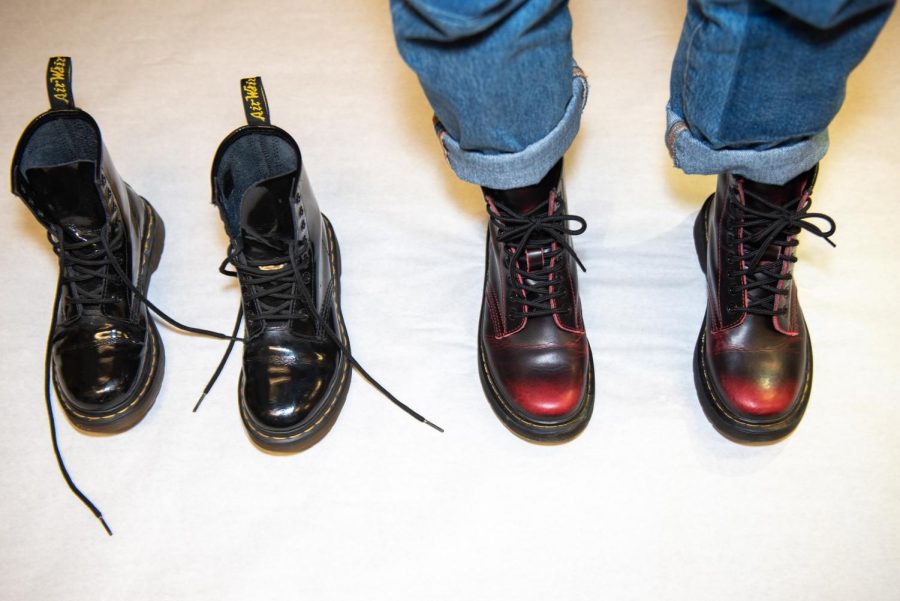Doc Martens: A Pillock Boot
Why you should not buy Doc Martens anymore
Docs have transformed from a utilitarian boot to a mainstream accessory worn by celebrities and Fordham students alike.
November 7, 2021
Doc Martens: an iconic British boot worn by humble postmen to rock superstars like Pete Townshend. Like many other British brands, Docs have transformed from a utilitarian boot to a mainstream accessory worn by celebrities and Fordham students alike. Its popularity is not just based on its iconic style but also a reputation built by decades of quality, durable construction and longevity. Yet for the past 20 years, Dr. Martens has wasted away a storied reputation. To understand its decline, you must first understand its origins.
A German or British Boot?
Doc Martens’ origins lay not in Britain, but in Germany. The company was founded by Klaus Märtens in 1947 after he partnered with a friend from his university to produce a boot design he created himself. He came up with the design that utilized air-cushioned soles after injuring his ankle while serving in the German army.
At first, the two sold the majority of their boots to housewives, but by 1952, their sales had increased to the point that they attracted the attention of British shoe manufacturer the R. Griggs Group. In 1952, the R. Griggs Group bought the patent rights to manufacture the boot in Britain and changed the name from Märtens to “Dr. Martens.”
During the 1960s, “Docs” became popular first with blue-collar workers then with scooter riders, punks and other youth subcultures. It was during the late 1960s and 1970s when the shoes’ popularity was cemented in youth culture.
In 2003, declining revenues forced Doc Martens close to bankruptcy, leading the company to shut down U.K. production and outsource their production to cheaper East Asian manufacturers. This, along with a relaunch of its product line, brought the company back from solvency and led to it being acquired by the private equity firm Permira in 2013.
Since its acquisition by Permira, Doc Martens experienced record revenue growth. In 2019 alone, its revenue was £454 million, a six-fold increase since 2013. But what was the cost? Before the 2000s, Doc Martens manufactured nearly all its boots in Britain at its original Cobbs Lane factory in Wollaston, Northamptonshire. Yet after its near bankruptcy and acquisition, Doc Martens now only produces 1% of its boots in the U.K as of 2018.
The question is: Are Doc Martens still worth it?
A Rip-Off
The question is: Are Doc Martens still worth it? Well, it is complicated. To the average Fordham student who wears boots solely for their looks, yes, Doc Martens are a decent pair of (overpriced) boots. To those who care about the quality of their footwear and where their money goes, Docs are not worth it.
In 2019, The Guardian published an article detailing dozens of customer complaints about the boot’s decline in quality after its acquisition. One longtime owner detailed sentiments shared by many other customers: “I have two otherwise identical pairs of Dr. Martens boots — one U.K. made, one Chinese-made — and while the U.K.-made ones are among the most comfortable footwear I own, the Chinese-made ones (are) made of nasty, rigid, thinner leather.”
Another passionate owner from London wrote, “The replacement pair has a glued-in flat-foam insole which leaves a gap between it and the inside of the boot. Not only that but the leather that comprises the tongue is 0.2mm thinner — 1.4 mm compared to 1.6 mm of the previous pair.”
It is consumers’ continued purchase of overpriced, lower-quality products that enables a company to shift to offshore production.
The perceived decline of Doc Martens is not just an isolated case but rather emblematic of an industry trend whereby companies by their own accord — or after being bought out — shift production from their home countries to cheaper regions such as Southeast Asia and South America. Storied brands like Barbour, Allen Edmonds and Schotts have all shifted production overseas to reduce costs and quality while raising prices.
If you would like an in-depth breakdown of the shortcomings of Doc Martens, I’d recommend this article comparing foreign-made Doc Martens to an American-made competitor: The Iron Ranger.
Spineless Consumers
At this point, some readers might be wondering, “So what?” “So what if I buy a foreign-made boot if it is comfortable and decent quality in my mind?” Such an attitude toward specific products is what caused their quality decline in the first place. It is consumers’ continued purchase of overpriced, lower-quality products that enables a company to shift to offshore production, reduce quality and jack up prices to exorbitant amounts while raking in record profits.
Voting with your wallet can be a powerful sign to companies to change their practices — just look at the video game industry and microtransactions.
Personally, knowing where my clothes and footwear come from is a matter of principle and pride. Before many brands offshored their manufacturing, their local factories in America or Europe supported hundreds, if not thousands, of skilled workers and supported many towns and cities. Corporate greed has been the death knell not just for the American and British clothing and footwear workers but also automobile and factory workers.
What sets the situation with Doc Martens apart from others is you can still choose to support the right company. Solovair is a British-made boot brand manufactured by NPS Shoes in Northamptonshire, U.K. They have made hand-made British shoes in the Northamptonshire factory since 1881 and during the 1960s, they were contracted by the R. Griggs Group to manufacture the iconic Doc Martens boot with a Solovair sole and Griggs upper. This partnership continued until the mid-1990s until Doc Martens began shifting production offshore.
The only way to put an end to this practice of corporate greed is to begin genuinely caring about the manufacturing source and ethics of the companies.
In 1995, however, Solovair trademarked its name, enabling it to make its air-cushioned boots that once created British-made Doc Martens during the 1960s. Nowadays, Solovair continues to make boots of their design and similar designs to original Doc Martens in the Northamptonshire factory.
When comparing Solovair’s Black Greasy 8 Eye Derby boots to Doc Martens’ 1460 Vintage Made in England boots, it is evident that their appearance and price are almost identical, coming in at $225 and $230, respectively, and adorned with white stitching and yellow stitching, respectively. The main difference is Solovair’s quality and the fact that it did not employ dubious business practices that cost hundreds of British workers their jobs and slashed its quality in pursuit of profit.
The only way to put an end to this practice of corporate greed is to begin genuinely caring about the manufacturing source and ethics of the companies by not turning a blind eye for the sake of cheapness and looks.
The Observer is Fordham Lincoln Center’s award-winning, 100% student-run newspaper. Donate to The Observer’s GiveCampus campaign to support student journalism today!

















David • Jan 24, 2022 at 3:36 pm
I watched the BBC documentary How it’s made re Doctor Martins. 3 weeks earlier I had bought a pair of black Doctor Martin shoes. As the documentary led us to believe ‘ they are all made in Northampton’. On looking for the quality control sticker I was shocked to see that they were made in an Asian country. The shoes are slightly uncomfortable and after reading this article grossly overpriced at £116.00
Nik • Jan 24, 2022 at 11:50 am
Sick n tired of foreign crap, doesn’t matter if it’s clothes or materials or equipment all cheap and nasty materials, eBay and Amazon etc all full of Chinese made junk. I purposefully look at where my goods are made and steer away from Asian made goods-they are just not reliable. Like the article said, only way to win is with your wallet. 👍
Chris • Jan 9, 2022 at 3:44 pm
Where can I buy those red and black boots in the above photo? Really really like them.
Jorge • Jan 17, 2022 at 1:43 pm
Try the doc martens website. I’ve bought my last 4 pairs of docs from there, and a pair for my daughter. They’ve got A LOT of amazing styles. Also this article is crap. I’ve had an issue with one pair of docs in the past decade, and doc martens sent me a new pair, for free, no receipt, no hassle, and I didn’t even buy the defective pair of boots from the website. I got it at journey’s.
Phillip • Jan 2, 2022 at 8:42 pm
Have to agree 100%. Docs aren’t what they used to be. If you’re actually wearing them to work in or just an everyday quality footwear. I’ve had several pairs and swore by them as the most comfortable functional boot I’ve ever owned. The last 2 pair I bought lasted 3 months before the sides ripped open. Making them some of the most expensive pieces of crap I’ve ever bought. I guess they were the Asian boots but when I pay that kinda money for something I expect it to last longer than 3 months so I’ve shied away from the Solovair because who wants to pay that much for boots ever few months.
Jorge • Jan 17, 2022 at 1:53 pm
Same thing happened with a pair of docs I bought at journey’s. They were the all black 1460 mono. Split on the sides within 6 months and I was only wearing them once a week. I called the doc martens website number and they replaced the boots free of charge without a receipt or anything. I’ve bought 3 pairs since then and haven’t had any problems with any of them. If you’ve still got the boots, I recommend giving them a call. They had me send them a picture and mail the boots back and boom, new pair.
David Stanger • Jan 1, 2022 at 1:54 pm
I own a pair of ‘Asian’ Docs, and also a pair of Solovair. There is no comparison between the two, The Solovairs are streets ahead in quality and so much more comfortable. The Doc Martin’s don’t have a Shank, are inferior leather, and are nowhere as comfortable on the foot as the Solovair. Until people try Solovair they will still buy Docs thinking they are originals because of their name.
I’ll never buy Docs again, Solovair are so much better.
Fan Of Killjoy • Dec 27, 2021 at 11:00 pm
To the Boomer who thinks some American trade paper ruined the quality of shoes that were (formerly) made well in the UK – sit down and watch your Lil Tucker to pacify your tiny brain. The author of this article is exactly right and if you don’t believe them then do some research on it before you pop off your Trumpy mouth. I used to buy myself a pair of steel toe Docs every birthday and happy I did bc I have many pairs of well made leather Docs now to show for it. A few weeks ago I see this really cute pair of Docs so I snapped them up at a cost of $170 USD a steal imo has they been made like they used to be. These Docs are the most uncomfortable shoes I’ve ever paid any money for and you can bet I’m taking them back. Great article. You read my mind.
Kwan L Lowe • Dec 27, 2021 at 2:40 am
I’ve worn Doc Martens for years and still own pairs that I bought three decades ago. Owned over a dozen pairs in my lifetime. Bought some recently but will never buy them again. Both heels fell off one pair. On another, the zipper doesn’t stay up and the coating peeled off. Loved em before. Hate them now.
Noraida adam • Dec 18, 2021 at 9:41 am
When I was highschool I wish to have doctors Martin’s shoes color pink I remembered. When my mom bought for me, I was really happy but when I went to our neighbors and left the shoes near to the door it was gone. I cried a lot and I will never forget that day. Since that day I never had doctor Martin’s shoes just praying and saying once God decide to give to me it will be really for and I will keep and I will not let anyone used or touch it 🙂
Louise • Dec 14, 2021 at 2:49 pm
It is the classic style that makes the Docs delightful…Apart from the “doing time” wearing them in…but oh boy the pain is worth the gain..lol…I have Docs original from England and Asia..Love them both!!!! And not forgetting they are real leather…not some pu..with a designer label that cost about the same price…You either love these boots or hate them like the person who wrote the article
April Hawkins • Dec 14, 2021 at 10:20 am
I’ve got both Made in England and Asian Docs, along with vintage. Vintage is very good quality. Most of my MIE is good quality as well. Some of the imports are also very good quality, others not so much. I find it’s more of the style as opposed to the country of origin that determines the standard of quality. Regardless, I wear Docs exclusively.
Col • Dec 15, 2021 at 7:12 am
Vintage? They don’t last that long. I’ve been through loads of pairs. They only last long if you don’t wear them!😁
Jorge • Jan 17, 2022 at 1:59 pm
I agree completely. Depends on the style. I got the all black 1460 mono from journey’s and the quality was crap. Luckily, doc martens has an amazing warranty program and replaced then for free. I’ve had 4 pairs since then and haven’t had any issues from any of them. Awesome customer service and definitely a willing to please. Love my Docs!!
Erik Thompson • Dec 8, 2021 at 9:38 pm
The student writer isn’t old enough to understand the important history of docs. Nor is he old enough to remember when Clinton signed GATT and NAFTA which in essence triggered foreign mnfg of previously high quality products to less skilled labor forces. MAGA. Those of us in our 50s remember when it was. The youth of this country will never know.